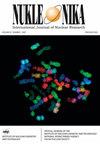γ辐照对冻干浆果微生物和营养特性的影响
IF 0.3
4区 物理与天体物理
Q4 CHEMISTRY, INORGANIC & NUCLEAR
引用次数: 1
摘要
摘要冷冻干燥是指通过升华从材料中去除冰或其他冷冻溶剂,并通过解吸过程去除结合的水分子的技术。干燥在−40°C至−50°C的绝对真空中进行。这种技术通常用于保护水果,尤其是浆果。在这个过程中,水从冻结变成气态,没有融化。由于低温和高真空度,大多数微生物在冷冻干燥过程中变得不活跃。然而,如果有必要销毁处理过的食物中的所有微生物,随后用伽马射线照射是一种合适的方法。本文研究了不同剂量的γ辐射对冻干浆果微生物特性的影响。研究表明,7 kGy的辐射剂量足以消除微生物总数(不包括霉菌),只要微生物总数低于塞尔维亚共和国食品微生物安全法允许的限度,5 kGy就足以使霉菌失去活性。还得出结论,伽马射线照射不会影响冻干浆果的营养价值。本文章由计算机程序翻译,如有差异,请以英文原文为准。
Effect of gamma irradiation on microbiological and nutritional properties of the freeze-dried berries
Abstract Lyophilization or freeze-drying is the technique of removing ice or other frozen solvents from a material through sublimation and the removal of bound water molecules through the process of desorption. Drying occurs in an absolute vacuum at temperatures from −40°C to −50°C. This technique is often used for the conservation of fruits, especially berries. During this process, the water changes from frozen to gaseous, with no thawing. Due to low temperatures and the high vacuum, most microorganisms are rendered inactive during the lyophilization process. However, if there is a necessity to destroy all microorganisms from treated food, subsequent irradiation with gamma rays is an appropriate method. This paper investigated the influence of different doses of gamma radiation on lyophilized berries’ microbiological characteristics. It was shown that the radiation dose of 7 kGy is sufficient to eliminate the total number of microorganisms (excluding molds) to the extent that the number falls below the permitted limit according t o the law on the microbiological safety of foodstuffs of the Republic of Serbia, and 5 kGy is enough for molds to be rendered inactive. It was also concluded that gamma irradiation does not affect the nutritional value of lyophilized berries.
求助全文
通过发布文献求助,成功后即可免费获取论文全文。
去求助
来源期刊

Nukleonika
物理-无机化学与核化学
CiteScore
2.00
自引率
0.00%
发文量
5
审稿时长
4-8 weeks
期刊介绍:
"Nukleonika" is an international peer-reviewed, scientific journal publishing original top quality papers on fundamental, experimental, applied and theoretical aspects of nuclear sciences.
The fields of research include:
radiochemistry, radiation measurements, application of radionuclides in various branches of science and technology, chemistry of f-block elements, radiation chemistry, radiation physics, activation analysis, nuclear medicine, radiobiology, radiation safety, nuclear industrial electronics, environmental protection, radioactive wastes, nuclear technologies in material and process engineering, radioisotope diagnostic methods of engineering objects, nuclear physics, nuclear reactors and nuclear power, reactor physics, nuclear safety, fuel cycle, reactor calculations, nuclear chemical engineering, nuclear fusion, plasma physics etc.
 求助内容:
求助内容: 应助结果提醒方式:
应助结果提醒方式:


